
www.philips.com/welcomewww.philips.com/welcome www.philips.com/welcome
User manual
Safety leaflet Warranty
a
b
d
l
m
c
e
g
h
i
f
j
k
HD3011
HD3012
HD3015
HD3016
HD3017
HD3018
HD3011
HD3012
HD3015
HD3016
HD3017
HD3018
HD3011
HD3012
HD3015
HD3016
HD3017
HD3018
1
EN User manual
ES-AR Manual del usuario
HI
MS-MY Manual pengguna
TH คมือผใช
VI Hướng dẫn sử dụng
ZH-CN 用户手册
All registered and unregistered trademarks are
property of their respective owners.
© 2012 Koninklijke Philips Electronics N.V.
All rights reserved.
HD3011_HD3012_HD3015_HD3016_HD3017_HD3018_UM_AS_V1.0
Register your product and get support at
www.philips.com/welcome
HD3011
HD3012
HD3015
HD3016
HD3017
HD3018
English
1 Your rice cooker
Congratulations on your purchase, and welcome to Philips!
To fully benet from the support that Philips offers, register your
product at www.Philips.com/welcome.
2 What’s in the box
Rice cooker main unit Steam basket
Rice scoop Measuring cup
User manual Safety leaet
Warranty card Power cord
Overview
a
Inner pot
h
Lid release button
b
Water level indications
i
Detachable steam vent cap
c
Scoop holder
j
Main body
d
Heating element
k
Power socket
e
Control Key
l
Keep warm indicator
f
Steam water storage
m
Cooking indicator
g
Outer lid
3 Using the rice cooker
Before rst use
1 Take out all the accessories from the inner pot. Remove the
packaging material of the inner pot.
2 Clean the parts of the rice cooker thoroughly before using the
rice cooker for the rst time (see chapter ‘Cleaning’).
Note
• Make sure all parts are completely dry before you start using the rice cooker.
Preparations before use
Before using the rice cooker, you need to follow the preparation:
1 Measure the rice using the measuring cup provided.
2 Wash the rice thoroughly.
3 Put the pre-washed rice in the inner pot.
4 Add water to the level indicated on the scale inside the inner
pot that corresponds to the number of cups of rice used. Then
smooth the rice surface.
5 Press the release lever to open the lid.
6 Put the inner pot in the rice cooker. Check if the inner pot is in
proper contact with the heating element.
7 Close the lid of the rice cooker, put the plug in the power socket.
Note
• Each cup of uncooked rice normally gives 2 bowls of cooked rice. Do
not exceed the quantities indicated on the inside of the inner pot.
• The level marked inside the inner pot is just an indication. You can
always adjust the water level for different types of rice and your own
preference. If the voltage is unstable at the area you live, it is possible
that the rice cooker overows.
• Besides following the water level indications, you can also add rice and
water at 1:1-1.2 ratio for rice cooking. Do not exceed the quantities
indicated on the inside of the inner pot.
• Make sure that the outside of the inner pot is dry and clean, and that there
is no foreign residue on the heating element or the magnetic switch.
Cooking rice
1 Follow the steps in “Preparations before use”.
2 Press down the control key, and the cooking (
) indicator
lights up.
3 When the cooking is nished, the cooking (
) indicator
will be off.
4 The rice cooker switches to keep warm mode automatically, and
the keep warm (
) indicator lights up.
Note
• Do not exceed the volume indicated nor exceed the maximum water level
indicated in the inner pot, as this may cause the rice cooker to overow.
Steaming
1 Measure a few cups of water with the measuring cup.
2 Pour the water into the inner pot.
3 Put the steam basket into the inner pot.
4 Put the food into the steam basket.
5 Close the lid of the rice cooker, and put the plug in the power
socket.
6 Push down the control key, and the cooking (
) indicator
lights up.
7 When the steaming is nished, pull up the control key.
8 The rice cooker switches to keep warm mode, and the keep
warm (
) indicator lights up.
Note
• Use a kitchen glove or a cloth, as the plate and steam basket will be
very hot.
• You can cook rice while steaming food. Do not exceed the volume
indicated nor immerse the steam basket in the water, as this may cause
the rice cooker to overow.
• You can adjust the water level as needed.
Specications
Model Number HD3011/
HD3012
HD3015/
HD3016
HD3017/
HD3018
Rated power output 500W 650W 650W
Rated capacity 3.0L 4.0L 5.0L
Rice volume (cups) 1L (1-6) 1.5L (1-8) 1.8L (1-10)
4 Cleaning and Maintenance
Note
• Unplug the rice cooker before starting to clean it.
• Wait until the rice cooker has cooled down sufciently before cleaning it.
Interior
Inside of the outer lid and the main body:
• Wipe with wrung out and damp cloth.
• Make sure to remove all the food residues stuck to the rice
cooker.
Heating element:
• Wipe with wrung out and damp cloth.
• Remove food residues with wrung out and damp cloth or
toothpicks.
Exterior
Surface of the outer lid and outside of the main body:
• Wipe with a cloth damped with soap water.
• ONLY use soft and dry cloth to wipe the control panel.
• Make sure to remove all the food residues around the control
buttons.
Accessories
Rice scoop, inner pot, steam basket, steam vent cap:
• Soak in hot water and clean with sponge.
5 Environment
Do not throw away the appliance with normal household
waste at the end of its life, but hand it in at an ofcial collection
point for recycling. By doing this, you can help to preserve the
environment.
6 Guarantee and service
If you need service or information, or if you have a problem, visit the
Philips website at www.philips.com or contact the Philips Customer
Care Center in your country. You can nd its phone number in the
worldwide guarantee leaet. If there is no Customer Care Center in
your country, go to your local Philips dealer.
7 Troubleshooting
Problem Solution
The lights on the
buttons does not
go on.
There is a connection problem. Check if
the power cord is connected to the cooker
properly and if the plug is inserted rmly into
the power outlet.
The light is defective. Take the appliance
to your Philips dealer or a service center
authorized by Philips.
The rice is not cooked. There is not enough water. Add water
according to the scale on the inside of the
inner pot.
You did not press down the control key.
Make sure that there is no foreign residue on
the heating element and the outside of the
inner pot before switching the rice cooker on.
The heating element is damaged, or the inner
pot is deformed. Take the cooker to your
Philips dealer or a service center authorized
by Philips.
The rice is not well
cooked.
Add more water.
The cooker does not
switch to keep warm
mode automatically in
"Rice Cooking" mode.
The temperature control is defective. Take
the appliance to your Philips dealer or a
service center authorized by Philips.
The rice is scorched. You have not rinsed the rice properly. Rinse
the rice until water runs clear.
Water spills out of
the rice cooker during
cooking.
• Make sure that you add water to the level
indicated on the scale inside the inner pot
that corresponds to the number of cups
of rice used.
• Make sure the water does not exceed the
next level on the scale, as this may cause
the appliance to overow during cooking.
Rice smells bad after
cooking
Clean the inner pot with some washing
detergent and warm water.
After cooking, make sure the steam vent cap,
inner lid and inner pot is cleaned thoroughly.
Español
1 Su arrocera
Felicitaciones por su compra y bienvenido a Philips!
Para usar los servicios de asistencia técnica de Philips, registre su
producto en www.philips.com/welcome.
2 Contenido de la caja
Unidad principal de la arrocera Cestilla de vapor
Cuchara para arroz Tapón medidor
Manual del usuario Folleto de seguridad
Tarjeta de garantía Cable de alimentación
Descripción general
a
Recipiente interno
h
Botón de apertura de la tapa
b
Indicaciones de nivel de agua
i
Tapa desmontable de
ventilación de vapor
c
Soporte para cuchara
j
Cuerpo principal
d
Placa de calentamiento
k
Toma de corriente
e
Botón de control
l
Indicador de conservación
del calor
f
Almacenamiento de vapor
de agua
m
Indicador de cocción
g
Tapa exterior
3 Uso de la arrocera
Antes del primer uso
1 Saque todos los accesorios del recipiente interno. Retire el
material de envasado del recipiente interno.
2 Limpie a fondo las piezas de la arrocera antes de usar el artefacto
por primera vez (consulte el capítulo “Limpieza”).
Nota
• Asegúrese de que todas las piezas estén completamente secas antes de usar
la arrocera.
Preparaciones antes del uso
Antes de usar la arrocera, debe seguir la preparación:
1 Mida la cantidad de arroz con el vaso medidor suministrado.
2 Lave bien el arroz.
3 Eche el arroz previamente lavado en el recipiente interior.
4 Añada agua hasta el nivel indicado en la escala del recipiente
interior que se corresponda con la cantidad de vasos de arroz
utilizados. A continuación, alise la supercie del arroz.
5 Presione la palanca para abrir la tapa.
6 Coloque el recipiente interior en la arrocera. Revise si el
recipiente interno está adecuadamente conectado al calentador.
7 Cierre la tapa de la arrocera y enchúfela a la toma de
alimentación.
Nota
• Cada vaso de arroz crudo da normalmente 2 tazones de arroz cocido.
No sobrepase las cantidades indicadas al interior del recipiente interno.
• El nivel marcado en el recipiente interno es solo una indicación.
Siempre puede ajustar el nivel de agua para los distintos tipos de arroz
y a su preferencia. Si el voltaje es inestable en el área donde vive, es
posible que la arrocera se desborde.
• Además de seguir las indicaciones de agua, también puede agregar
arroz y agua en una proporción de 1:1-1,2 para cocinarlo. No
sobrepase las cantidades indicadas al interior del recipiente interno.
• Asegúrese de que la parte externa del recipiente interior esté seca y
limpia, y de que no queden restos extraños en el calentador ni en el
interruptor magnético.
Cocción del arroz
1 Siga los pasos en “Preparaciones antes del uso”.
2 Pulse el botón de control, el indicador de cocción (
) se
encenderá.
3 Cuando termine la cocción, el indicador de cocción
(
) se apagará.
4 La arrocera cambia al modo de conservación del calor
automáticamente, el indicador de conservación del calor
(
) se encenderá.
Nota
• No sobrepase el volumen indicado ni sobrepase el nivel máximo de agua
indicado en el recipiente interno, ya que esto puede causar que la arrocera
se desborde.
Cocción al vapor
1 Mida algunos vasos de agua con el vaso medidor.
2 Vierta el agua en el recipiente interno.
3 Ponga la cestilla de vapor dentro del recipiente interno.
4 Ponga los alimentos en la cestilla de vapor.
5 Cierre la tapa de la arrocera y enchúfela a la toma de
alimentación.
6 Pulse el botón de control, el indicador de cocción (
) se
encenderá.
7 Cuando se detenga el vapor, levante el botón de control.
8 La arrocera cambia al modo de conservación del calor
automáticamente, el indicador de conservación del calor
(
) se encenderá.
Nota
• Utilice un guante de cocina o un paño, ya que la placa y la cestilla de
vapor estarán muy calientes.
• Puede preparar arroz mientras cocina alimentos al vapor. No
sobrepase el volumen indicado ni sumerja la cestilla de vapor en agua,
ya que esto puede causar que la arrocera se desborde.
• Puede ajustar el nivel de agua como sea necesario.
Especicaciones
Número de modelo HD3011/
HD3012
HD3015/
HD3016
HD3017/
HD3018
Salida nominal 500 W 650 W 650 W
Capacidad nominal 3,0 L 4,0 L 5,0 L
Volumen de arroz (tazas) 1 L (1-6) 1,5 L (1-8) 1,8 L (1-10)
4 Limpieza y mantenimiento
Nota
• Desenchufe la arrocera antes de comenzar a limpiarla.
• Antes de limpiar la arrocera, espere a que se enfríe.
Interior
Dentro de la tapa exterior y el cuerpo principal:
• Limpie con un paño escurrido y húmedo.
• Asegúrese de eliminar todos los residuos de comida adheridos a
la arrocera.
Calentador:
• Limpie con un paño escurrido y húmedo.
• Retire los residuos de comida con un paño escurrido y húmedo o
un mondadientes.
Exterior
Supercie de la tapa exterior y parte externa del cuerpo principal:
• Limpie con un paño humedecido con agua jabonosa.
• Para limpiar el panel de control utilice SOLO un paño suave y
seco.
• Asegúrese de quitar todos los residuos de alimentos alrededor de
los botones de control.
Accesorios
Cuchara para arroz, recipiente externo, cestilla de vapor, tapa de
ventilación de vapor:
• Remójelos en agua caliente y límpielos con una esponja.
5 Medioambiental
Cuando nalice la vida útil del aparato, no lo deseche junto
con los residuos normales del hogar. Llévelo a un punto de
recolección ocial para su reciclado. De esta manera, ayudará a
conservar el medio ambiente.
6 Garantía y servicio técnico
Si necesita servicio, información, o si tiene un problema, visite el sitio
www.philips.com o contáctese con el Centro de atención al cliente de
Phillips en su país. Puede encontrar el número de teléfono en el folleto
de garantía mundial. Si no existe un Centro de atención al cliente en su
país, diríjase al distribuidor de Philips local.
7 Solución de problemas
Problema Solución
Las luces de los botones
no se encienden.
Hay un problema de conexión. Revise si
el cable de alimentación está conectado a
la arrocera adecuadamente y si el enchufe
está rmemente insertado en la toma de
alimentación.
La luz está fallada. Lleve el aparato a
su distribuidor Philips o a un centro de
servicio autorizado por Philips.
El arroz no está cocido. No hay agua suciente. Agregue agua de
acuerdo a la escala que se encuentra en el
recipiente interno.
No presionó el botón de control.
Asegúrese de que no haya residuos
extraños en el calentador y en el exterior
del recipiente interno antes de encender
la arrocera.
El calentador está dañado o el recipiente
interno está deforme. Lleve el aparato a
su distribuidor Philips o a un centro de
servicio autorizado por Philips.
El arroz no está bien
cocido.
Agregue más agua.
La arrocera no enciende
automáticamente el
modo de conservación
del calor en el modo
"Rice Cooking" (cocción
de arroz).
El control de temperatura tiene alguna
falla. Lleve el aparato a su distribuidor
Philips o a un centro de servicio autorizado
por Philips.
El arroz se quemó. No enjuagó el arroz adecuadamente.
Enjuague el arroz hasta que el agua corra
clara.
Durante la cocción, la
arrocera derrama agua.
• Asegúrese de que agregó agua hasta el
nivel indicado en la escala del recipiente
interior que corresponda con la
cantidad de vasos de arroz utilizados.
• Asegúrese de que el agua no sobrepasa
el nivel siguiente en la escala, ya que
esto puede causar que el aparato se
desborde durante la cocción.
El arroz tiene mal olor
después de la cocción
Limpie el recipiente interno con un poco
de detergente y agua tibia.
Después de cocinar, asegúrese de limpiar
bien la tapa de ventilación de vapor, la tapa
interior y el recipiente interno.
1
Philips !
Philips , www.
Philips.com/welcome .
2
a
h
b
i
c
j
d
k
e
l
f
m
g
3
1 . .
2
( ‘’ ).
•
.
, :
1 .
2 .
3 .
4
. .
5 .
6 .
.
7 , .
• 2 .
.
• .
.
.
• ,
1:1-1.2 . .
• ,
.
What’s in the box Contenido de la caja
Apa dalam kotak ini
ภายในกลองมีอะไรบาง Trong hộp có gì
包装盒内物品
Steaming Cocción al vapor
Mengukus
การนึ่งอาหาร Hp thc ăn
蒸食品
Cooking rice Cocción del arroz
Memasak nasi
วิธีหุงขาว Cch nu cơm
煮饭
Using the rice cooker Uso de la arrocera
Menggunakan pemasak nasi
การใชหมอหุงขาว Sử dụng nồi cơm điện
使用电饭煲
1 “ ” .
2 , (
) .
3 , (
) .
4 ,
(
) .
•
.
1 .
2 .
3 .
4 .
5 .
6 , (
) .
7 , .
8 , (
)
.
• ,
.
• .
.
• .
HD3011/
HD3012
HD3015/
HD3016
HD3017/
HD3018
500W 650W 650W
3.0L 4.0L 5.0L
()
1L (1-6) 1.5L (1-8) 1.8L (1-10)
4
• .
• .
:
• .
• .
:
• .
• .
:
• .
• .
• .
, , , :
• .
5
.
.
6
Philips
www.philips.com Philips .
.
Philips .
7
.
.
.
. Philips
Philips .
. .
.
.
.
,
. Philips Philips
.
. .
" "
.
. Philips
Philips
.
. .
.
.
•
.
•
,
.
.
.
, ,
.
Bahasa Melayu
1 Pemasak nasi anda
Tahniah atas pembelian anda dan selamat menggunakan Philips!
Untuk mendapatkan manfaat sepenuhnya daripada sokongan yang
ditawarkan oleh Philips, daftarkan produk anda di
www.philips.com/welcome.
2 Apa dalam kotak ini
Unit utama pemasak nasi Bakul kukus
Senduk nasi Cawan penyukat
Manual pengguna Risalah keselamatan
Kad waranti Kord kuasa
Gambaran keseluruhan
a
Periuk dalam
h
Butang pelepas tudung
b
Penunjuk paras air
i
Tukup bolong stim boleh tanggal
c
Pemegang senduk
j
Jasad utama
d
Elemen pemanasan
k
Soket kuasa
e
Kekunci Kawalan
l
Penunjuk simpan panas
f
Penyimpanan air stim
m
Penunjuk memasak
g
Tudung luar
3 Menggunakan pemasak nasi
Sebelum penggunaan pertama
1 Keluarkan semua aksesori dari periuk dalam. Alih keluar bahan
pembungkusan periuk dalam.
2 Bersihkan bahagian pemasak nasi dengan menyeluruh sebelum
anda menggunakan pemasak nasi buat kali pertama (lihat bab
‘Pembersihan’).
Catatan
• Pastikan semua bahagian telah kering sepenuhnya sebelum anda mula
menggunakan pemasak nasi.
Persediaan sebelum menggunakan
Sebelum menggunakan pemasak nasi, anda perlu mengikuti penyediaan
tersebut:
1 Ukur beras menggunakan cawan penyukat yang disediakan.
2 Basuh beras dengan sempurna.
3 Tuangkan beras yang sudah dibasuh ke dalam periuk dalam.
4 Tambahkan air sehingga paras yang ditunjukkan pada skala di
bahagian dalam periuk dalam, yang sepadan dengan bilangan
cawan beras yang digunakan. Kemudian, ratakan permukaan beras.
5 Tekan butang pelepas untuk membuka tudungnya.
6 Masukkan periuk dalam ke dalam pemasak nasi. Periksa sama ada
periuk dalam bersentuhan dengan betul dengan elemen pemanas.
7 Tutup tudung periuk pemasak nasi, dan masukkan plag ke dalam
soket kuasa.
Catatan
• Setiap cawan beras biasanya menghasilkan 2 mangkuk nasi. Jangan
melebihi kuantiti yang ditunjukkan di bahagian dalam periuk dalam.
• Paras yang ditandai di dalam periuk dalam hanyalah penunjuk. Anda
sentiasa boleh melaraskan aras air untuk berlainan jenis beras dan
keutamaan anda. Jika voltan di kawasan anda tinggal tidak stabil,
pemasak nasi mungkin melimpah.
• Selain dari mengikut penunjuk paras air, anda juga boleh menambah
beras dan air pada nisbah 1:1-1.2 untuk memasak nasi. Jangan melebihi
kuantiti yang ditunjukkan di bahagian dalam periuk dalam.
• Pastikan bahawa bahagian luar periuk dalam adalah kering dan bersih,
dan bahawa tiada sisa asing pada elemen pemanasan atau suis magnet.
Memasak nasi
1 Ikuti langkah dalam “Persediaan sebelum menggunakan”.
2 Tekan kekunci kawalan ke bawah, dan penunjuk memasak
(
) menyala.
3 Apabila memasak selesai, penunjuk (
) memasak akan
mati.
4 Pemasak nasi bertukar ke mod simpan panas secara automatik,
dan penunjuk simpan panas (
) menyala.
Catatan
• Jangan melebihi isi padu yang ditunjukkan mahupun melebihi paras air
maksimum yang ditunjukkan di dalam periuk dalam, kerana ini boleh
menyebabkan pemasak nasi melimpah.
Mengukus
1 Sukat beberapa cawan air dengan cawan penyukat.
2 Tuang air ke dalam periuk dalam.
3 Letakkan bakul kukus di dalam periuk dalam.
4 Letakkan makanan ke dalam bakul mengukus.
5 Tutup tudung pemasak nasi dan pasangkan plag ke dalam soket
dinding.
6 Tekan kekunci kawalan ke bawah dan penunjuk (
)
memasak menyala.
7 Apabila pengukusan selesai, tarik ke atas kekunci kawalan.
8 Pemasak nasi bertukar ke mod simpan panas, dan penunjuk
simpan panas (
) menyala.
Catatan
• Gunakan sarung tangan dapur atau kain, kerana pinggan dan bakul
kukus sangat panas.
• Anda boleh memasak nasi semasa mengukus makanan. Jangan melebihi
isipadu yang ditunjukkan atau merendam bakul stim di dalam air, kerana
ini boleh menyebabkan pemasak nasi melimpah.
• Anda boleh melaraskan paras air seperlunya.
Spesikasi
Nombor Model HD3011/
HD3012
HD3015/
HD3016
HD3017/
HD3018
Output kuasa yang ditarafkan 500W 650W 650W
Kapasiti yang ditarafkan 3.0L 4.0L 5.0L
Jumlah beras (cawan) 1L (1-6) 1.5L (1-8) 1.8L (1-10)
4 Pembersihan dan Penyelenggaraan
Catatan
• Cabut plag perkakas setiap kali sebelum anda mula membersihkannya.
• Tunggu sehingga periuk pemasak nasi telah sejuk secukupnya sebelum
membersihkannya.
Dalaman
Di bahagian dalam tudung luar dan badan utama:
• Lap dengan kain lembap yang telah diperah.
• Pastikan semua sisa makanan yang melekat pada pemasak nasi
dibuang.
Elemen pemanas:
• Lap dengan kain lembap yang telah diperah.
• Buang sisa makanan dengan kain lembap yang telah diperah atau
cungkil gigi.
Luaran
Permukaan tudung luar dan bahagian luar jasad utama:
• Lap dengan kain yang dilembapkan dengan air sabun.
• HANYA gunakan kain lembut dan kering untuk melap panel
kawalan.
• Pastikan semua sisa makanan di sekeliling butang kawalan dibuang.
Aksesori
Senduk nasi, periuk dalam, bakul stim, tukup bolong stim:
• Rendam di dalam air panas dan bersihkan dengan span.

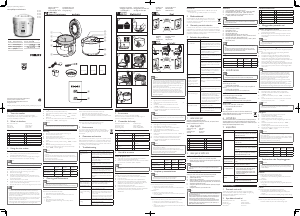


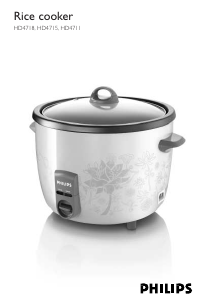

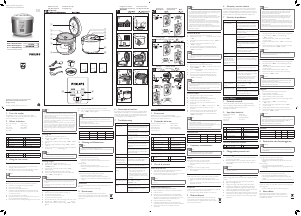
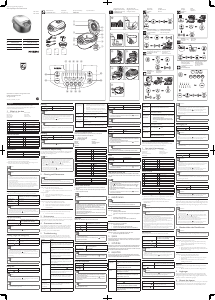
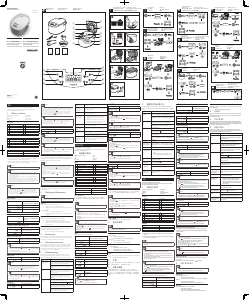
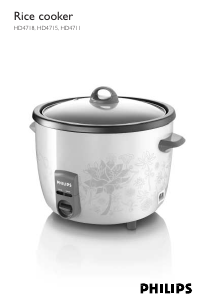

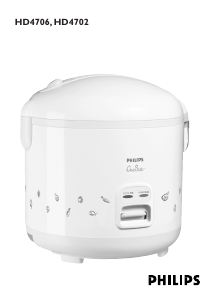
Tham gia cuộc trò chuyện về sản phẩm này
Tại đây bạn có thể chia sẻ suy nghĩ của mình về Philips HD3017 Nồi cơm điện. Nếu bạn có thắc mắc, trước tiên hãy đọc kỹ hướng dẫn. Yêu cầu một hướng dẫn có thể được thực hiện bằng cách sử dụng mẫu liên hệ của chúng tôi.